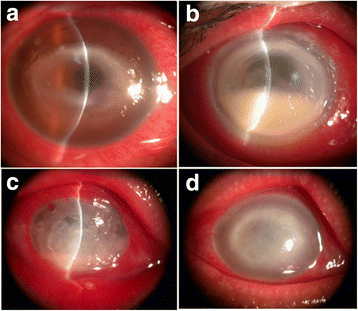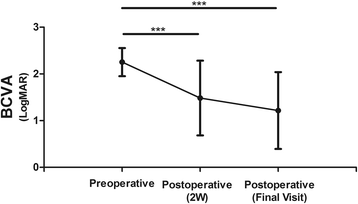Associated factors, diagnosis and management of Acanthamoeba keratitis in a referral Center in Southern China
- PMID: 28969610
- PMCID: PMC5625641
- DOI: 10.1186/s12886-017-0571-7
Associated factors, diagnosis and management of Acanthamoeba keratitis in a referral Center in Southern China
Abstract
Background: To analyse the associated factors, diagnosis, clinical manifestations and therapeutic effects of Acanthamoeba keratitis at a tertiary ophthalmic centre in Southern China.
Methods: A retrospective clinical study was performed in fifteen patients who were admitted to Zhongshan Ophthalmic Centre (ZOC) from January 2004 to December 2014. The patients' pathogenesis-associated factors were analysed, and preoperative diagnoses were determined using corneal scraping cultures and/or confocal microscopy followed. All diagnoses were confirmed by postoperative pathological examinations. At follow-up, best-corrected visual acuity (BCVA), the recurrence rate and graft transparency were evaluated to assess therapeutic effects.
Results: The main pathogenic factors observed in the fifteen patients were a history of injury or a foreign body entering the eyes (12 cases). In all, Acanthamoeba keratitis was preoperatively diagnosed in 5 cases using corneal scraping cultures or confocal microscopy. Ocular symptoms included redness, photophobia, tearing, and blurred vision. Penetrating keratoplasty was performed in thirteen patients, and postoperative pathological examinations were performed to confirm these diagnoses. The logarithm of the minimum angle of resolution (logMAR) of visual acuity was significantly improved after keratoplasty (p < 0.01). No recurrence was observed, and approximately 90% of the corneal grafts were found to be transparent during the follow-up period.
Conclusions: Corneal trauma may be the main pathogenic factor that causes Acanthamoeba keratitis in southern China. Corneal scraping combined with confocal microscopy was helpful for achieving a correct diagnosis. Early keratoplasty combined with amoebicidal therapy is an effective treatment strategy in Acanthamoeba keratitis.
Keywords: Acanthamoeba keratitis; Associated factors; Diagnosis; Keratoplasty.
Conflict of interest statement
Ethics approval and consent to participate
Our study was performed in a manner consistent with the tenets of the Declaration of Helsinki. All medical records were anonymized, and all information was used only for research purposes. All persons enrolled provided informed consent prior to their inclusion in the study. The study was approved by the Investigational Review Board of Zhongshan Ophthalmic Centre, Sun Yat-sen University, Guangzhou, China.
Consent for publication
All authors consent to the publication of this manuscript.
Competing interests
The authors declare that they have no competing interests.
Publisher’s Note
Springer Nature remains neutral with regard to jurisdictional claims in published maps and institutional affiliations.
Figures




Similar articles
-
Early Penetrating Keratoplasty À Chaud May Improve Outcome in Therapy-Resistant Acanthamoeba Keratitis.Adv Ther. 2019 Sep;36(9):2528-2540. doi: 10.1007/s12325-019-01031-3. Epub 2019 Jul 17. Adv Ther. 2019. PMID: 31317392
-
Keratoplasty for treatment of Acanthamoeba keratitis.Ophthalmology. 2009 May;116(5):864-9. doi: 10.1016/j.ophtha.2008.12.029. Ophthalmology. 2009. PMID: 19410943
-
Delayed diagnoses of Acanthamoeba keratitis at a tertiary care medical centre.Acta Ophthalmol. 2021 Dec;99(8):916-921. doi: 10.1111/aos.14792. Epub 2021 Feb 14. Acta Ophthalmol. 2021. PMID: 33583148
-
Treatment of Acanthamoeba keratitis.Cornea. 1998 Jan;17(1):11-6. doi: 10.1097/00003226-199801000-00002. Cornea. 1998. PMID: 9436874 Review.
-
New approach to diagnosis and treatment of Acanthamoeba keratitis--systematic review of literature.Klin Oczna. 2012;114(4):311-6. Klin Oczna. 2012. PMID: 23461162
Cited by
-
The Autofluorescence Patterns of Acanthamoeba castellanii, Pseudomonas aeruginosa and Staphylococcus aureus: Effects of Antibiotics and Tetracaine.Pathogens. 2021 Jul 14;10(7):894. doi: 10.3390/pathogens10070894. Pathogens. 2021. PMID: 34358044 Free PMC article.
-
Assessment of genotypes, endosymbionts and clinical characteristics of Acanthamoeba recovered from ocular infection.BMC Infect Dis. 2022 Sep 29;22(1):757. doi: 10.1186/s12879-022-07741-4. BMC Infect Dis. 2022. PMID: 36175838 Free PMC article.
-
The most abundant cyst wall proteins of Acanthamoeba castellanii are lectins that bind cellulose and localize to distinct structures in developing and mature cyst walls.PLoS Negl Trop Dis. 2019 May 16;13(5):e0007352. doi: 10.1371/journal.pntd.0007352. eCollection 2019 May. PLoS Negl Trop Dis. 2019. PMID: 31095564 Free PMC article.
-
Comparison of therapeutic effects between big-bubble deep anterior lamellar keratoplasty and penetrating keratoplasty for medically unresponsive Acanthamoeba keratitis.BMC Infect Dis. 2024 Mar 4;24(1):276. doi: 10.1186/s12879-024-09147-w. BMC Infect Dis. 2024. PMID: 38438857 Free PMC article.
-
Identification and Genotypic Characterization of Potentially Pathogenic Acanthamoeba Isolated from Tap Water in Wuxi, China.Korean J Parasitol. 2018 Dec;56(6):615-618. doi: 10.3347/kjp.2018.56.6.615. Epub 2018 Dec 31. Korean J Parasitol. 2018. PMID: 30630284 Free PMC article.
References
-
- Jones DB, Visvesvara GS, Robinson NM. Acanthamoeba polyphaga keratitis and Acenthamoeba uveitis associated with fatal meningoencephalitis. Trans Ophthalmol Soc UK. 1975;95:221–232. - PubMed
-
- Dart JK, Saw VP, Kilvington S. Acanthamoeba keratitis: diagnosis and treatment update 2009.Am J Ophthalmol. 2009 Oct;148(4):487–499.e2. - PubMed
MeSH terms
Substances
LinkOut - more resources
Full Text Sources
Other Literature Sources
Medical

